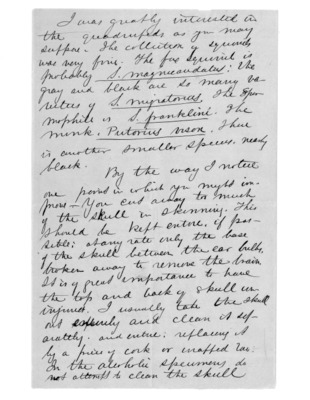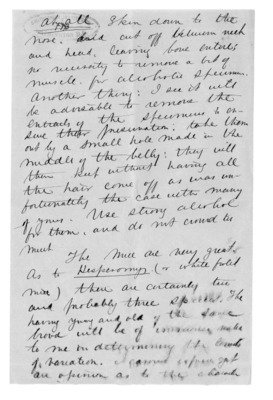Pages
page_0001
[stamp] SMITHSONIAN INSTITUTION [written] 773 [stamp] WASHINGTON D.C.
May 28' 1855
My Dear Robert
After writing and sending off one letter to-day, the express man brought the two boxes of specimens, all safe and in good condition. He also brought a box with two live white foot mice from Virginia, sent by another of my boys
The snakes were uncommonly lively: more so than ususal; they consisted of the kinds sent before; the Regina grahamii; were very handsome. I will have a first rate figure made of the brightest specimen.
The Salamanders consisted of the S. lurida (big black) Notoph- thalmus miniatus. (Sal. Symnutura of authors) and the Sal. Scutata, white belly. The Salamander in the bottle is the Nolophthalmus vindiscens. (Sal. dorsalis) - a very abundant aquatic species. By the way have I ever sent you my article on salamanders published ever so many years ago?
page_0002
I was greatly interested in the quadrupeds as you may suppose. The collection of squirrels was very fine. The fox squirrel is probably S. magnicanudatus: the gray and black are so many varieties of S.migratorius. The Spermophile is S. franklini. The mink. Putorius vison. There is another smaller species, nearly black.
By the way I noted one point in which you might improve - you cut away too much of the skull in skinning. This should be kept entire, if possible; at any rate only the base of the skull between the ear bulbs, broken away to remove the brain. It is of great importance to have the top and back of skull uninjured. I usually take the skull out entirely and clean it separately, and entire: replacing it by a piece of cork or [illegible]. In the alcoholic specimens do not attempt to clean the skull
page_0003
[stamp] SMITHSONIAN INSTITUTION [written] 773 [stamp] WASHINGTON D.C.
at all [double underline]. Skin down to the nose, and cut off between neck and head, leaving bone entire; no necessity to remove a bit of muscle. for alcoholic specimen. Another thing: I see it will be advisable to remove the entrails of the specimens to ensure their preservation; take them out by a small hole made in the middle of the belly: they will then keep without having all the hair come off as was unfortunately the case with many of yours. Use strong alcohol for them, and do not crowd too much
The mice are very great. As to Hesperomys (or white footed mice) there are certainly two and probably three species. The having young and old of the same brood will be of immense value to me in determining the limits of variation. I cannot express yet an opinion as to the character
page_0004
of the species, but wait for further observations from you. You have get the Arvicota oneida. The first I ever saw from the North. When I get some southern specimens I can then tell whether it is the same with A. peneto- rum, as supposed by Bartimer. There were two other species are the true A. riparius. However I will report fully on all these points later in the season.
Continue to indicate as well as secure what are young and old of the same specimens; these will be of very great value. Make as many skins as you can conveniently:
The bat is bespertiteo noctivagans: b. auduboni of [illegible]. The shrews, S. brevicanda & dekayi. You have heretofore sent Otisorex plu- lyshirios. ofDekay in alcohol: but there are several more with you - no doubt
Very truly Yours Spencer F Baird
Robt. Kennicott West Northfield Ill



